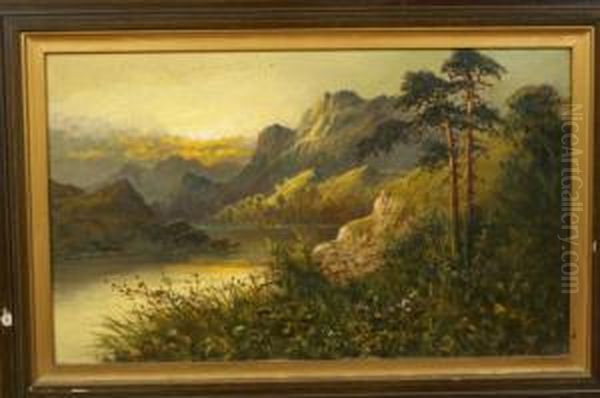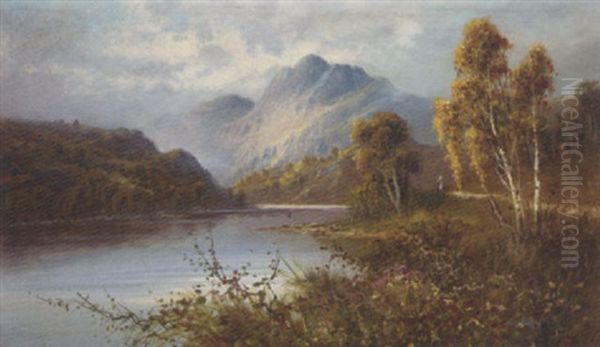Frank Hider stands as a notable figure in the tradition of British landscape painting, active during the late Victorian and Edwardian periods. Born in London in 1861 and passing away in 1933, Hider dedicated much of his artistic career to capturing the diverse and often dramatic scenery of the British Isles. He is particularly celebrated for his depictions of the Scottish Highlands, coastal vistas, and serene rural sunsets, demonstrating a keen eye for atmospheric effects and the nuances of natural light.
It is crucial, however, to address a point of potential confusion from the outset. Frank Hider, the British landscape artist (1861-1933), should not be mistaken for Frank Hinder (1906-1992), an Australian modernist painter known for his abstract and cubist-influenced works. While their names are similar, their artistic styles, nationalities, and periods of primary activity are distinctly different. This article focuses exclusively on Frank Hider, the British painter of landscapes.
A Life Rooted in Britain
Born in the bustling heart of the British Empire, London provided the starting point for Frank Hider's life. While specific details regarding his formal artistic training are not extensively documented in readily available sources, his body of work suggests a solid grounding in the techniques of oil painting prevalent during his time. His true education, perhaps, lay in his extensive travels throughout Great Britain.
Hider journeyed widely, seeking inspiration from the rugged coastlines of Cornwall and Wales to the misty lochs and mountains of Scotland, and the gentle, rolling hills of the English countryside. This immersion in the landscape allowed him to develop a deep familiarity with the specific qualities of light, weather, and topography that define different regions of Britain. His paintings are a testament to this direct observation, reflecting an authentic connection to the places he depicted.
Artistic Style: Capturing Atmosphere and Light

Frank Hider worked primarily in oils, employing a style that balanced realistic representation with a sensitivity to mood and atmosphere. His approach aligns broadly with the popular trends in landscape painting during the late 19th and early 20th centuries, favouring picturesque views rendered with considerable detail, yet often imbued with a romantic or evocative quality. He was particularly adept at capturing the transient effects of light, especially during sunrise and sunset.
His canvases often feature dramatic skies, with clouds catching the warm glow of the setting sun, casting long shadows across the land or reflecting in the still waters of a loch. The inclusion of small figures or animals, such as sheep or cattle, often serves to enhance the sense of scale and add a touch of pastoral life to the scene, grounding the majestic landscapes in a relatable human or natural context. His coastal scenes frequently capture the energy of the sea and the ruggedness of the shoreline, again paying close attention to the interplay of light on water and rock.
Hider's palette varied according to the scene and time of day, but he showed a fondness for the warm oranges, pinks, and golds of sunset, as well as the cooler blues and greys of twilight or moonlit scenes. His brushwork, while generally controlled to achieve a realistic finish, could also be expressive in conveying the texture of foliage, rocks, or moving water. He aimed not just to record a view, but to evoke the feeling of being present within the landscape.
Representative Works
Several paintings stand out as representative of Frank Hider's typical subjects and style. The Highland Sunset Sheep on Pathway beside Loch encapsulates many elements he is known for: the Scottish setting, the dramatic lighting of sunset, the presence of water (a loch), and the inclusion of pastoral elements (sheep on a path). This work likely showcases his skill in rendering atmospheric perspective and the warm colour palette associated with the end of the day in the Highlands.
Another significant work is Moonlit Street Scene, which is held in the collection of the National Trust at Rufford Old Hall, Lancashire. This painting demonstrates Hider's versatility in tackling different lighting conditions, moving from the brilliance of sunset to the subtle illumination of moonlight. Nocturnes like this require a masterful handling of tone and shadow to create depth and mystery, suggesting an influence or shared interest with artists like John Atkinson Grimshaw, who specialized in moonlit urban and dockland scenes.

Rural sunset with church and figure is another title indicative of his common themes, combining the popular motif of the village church, a symbol of enduring community within the landscape, with the evocative light of sunset and a human element. Similarly, Rocky Coast Scene at Sunset Painting, exhibited at the Grundy Art Gallery in Blackpool, points to his engagement with Britain's maritime scenery, capturing the interplay between land, sea, and sky at a favoured time of day. A work titled Solitude, offered at auction, suggests a focus on quiet, contemplative landscapes, perhaps featuring a lone figure or an isolated natural setting.
Hider in the Context of British Landscape Painting
Frank Hider worked during a period when landscape painting remained immensely popular in Britain, though artistic styles were beginning to diversify significantly. He can be situated within the lineage of Victorian and Edwardian landscape painters who continued to find inspiration in the natural beauty of the British Isles, following in the broader tradition established by giants like J.M.W. Turner and John Constable, albeit with a less revolutionary approach.
His contemporaries and near-contemporaries included artists who specialized in similar picturesque and often dramatic landscape subjects. Benjamin Williams Leader, for instance, was highly successful with his detailed views of the English and Welsh countryside, often featuring silver birches and tranquil rivers. Alfred de Bréanski Sr. and his family were renowned for their vibrant, sometimes intensely coloured depictions of the Scottish Highlands and Welsh mountains. Sidney Richard Percy, part of the Williams family of painters, also favoured detailed Highland and lake scenes. George Vicat Cole continued the tradition of lush, detailed English pastoral landscapes.
Hider's focus on specific atmospheric effects, particularly sunsets and moonlight, resonates with the work of John Atkinson Grimshaw, famous for his evocative nocturnes. While Grimshaw focused more on urban and dockside scenes, the shared interest in capturing the subtleties of low light provides a point of comparison. Hider's Highland scenes also place him alongside Scottish painters like Joseph Farquharson, known for his snow scenes often featuring sheep, and Peter Graham, celebrated for his dramatic Highland landscapes with cattle.
While these artists often shared subject matter, individual styles varied. Hider's work, generally speaking, maintained a commitment to realistic detail combined with atmospheric sensitivity, characteristic of much popular landscape art of the era. He operated largely outside the major modernist movements that were gaining momentum during the later part of his career, such as Post-Impressionism and Cubism, which were being explored by artists in London and continental Europe. His art remained firmly rooted in the established traditions of representational landscape painting.
Contrast his style with the Pre-Raphaelites like Dante Gabriel Rossetti or John Everett Millais, whose detailed naturalism served allegorical or narrative ends, or with the Aesthetic Movement figures like Albert Moore or Frederic Leighton, who prioritized formal beauty and classical themes. Even James McNeill Whistler, though also interested in atmosphere (especially in his 'Nocturnes'), pursued a more radical simplification of form and tonal harmony than Hider. Later developments in British landscape, such as the rural realism of artists like H. H. La Thangue or the coastal scenes of the Newlyn School painters like Stanhope Forbes, also show different stylistic priorities, often with looser brushwork and a greater focus on contemporary rural life and labour. Hider's work represents a continuation of the popular Victorian taste for scenic, often romanticized, views of nature.
A Family of Artists
An interesting aspect of Frank Hider's life is that artistic talent extended to the next generation. He reportedly had eight children, and at least two of them, his daughter Mabel Hider and son Christopher Hider, also became painters. This familial connection highlights a household potentially immersed in artistic practice.
Furthermore, it is noted that Mabel Hider may have signed her works using the initials "M.C. Hider." This has occasionally led to confusion, with some of her paintings being mistakenly attributed to her more famous father. This situation underscores the challenges that can arise in art historical attribution, particularly within artistic families where styles might share certain characteristics or where signatures can be ambiguous. It also suggests that Mabel Hider achieved a degree of proficiency that allowed her work to be mistaken for her father's, although it also points to the overshadowing effect a well-known artist parent can have on their children's independent recognition.
Collections, Exhibitions, and Market Presence
The inclusion of Frank Hider's work, specifically Moonlit Street Scene, in the National Trust collection at Rufford Old Hall signifies a level of recognition within established British heritage institutions. Public collections like the National Trust preserve works considered to be of cultural or historical value, making them accessible to a wider audience. His work Rocky Coast Scene at Sunset Painting being exhibited at the Grundy Art Gallery in Blackpool further indicates his participation in the public art sphere during or after his lifetime.
Frank Hider's paintings also continue to appear on the art market, featuring in auctions both large and small. References mention his work being sold at major auction houses like Sotheby's in the past, and more recently appearing in sales such as the "Fine & Classic" auction series and "Affordable & Fine Art" online sales. Titles like Rural sunset with church and figure and Solitude have been listed, with estimates suggesting his works are accessible to collectors of traditional British art, though prices can vary significantly based on size, condition, subject matter, and provenance. This ongoing market presence demonstrates a continued appreciation for his skillful and evocative depictions of the British landscape among collectors.
Art Historical Assessment and Legacy
Frank Hider occupies a solid, if not starring, role in the narrative of British art history. He was a proficient and often prolific painter who catered to the enduring public taste for picturesque and atmospheric landscape scenes. His specialization in the Scottish Highlands, coastal views, and particularly sunset and moonlight effects, allowed him to carve out a recognizable niche. He successfully captured the romantic beauty associated with the British landscape, providing appealing images for homes and public display.
While highly competent within his chosen genre, Hider is not generally regarded as an innovator who significantly altered the course of art history. His style remained largely traditional, untouched by the radical experiments of modernism that were emerging during his lifetime. Consequently, art historical evaluations tend to position him as a skilled representative of late Victorian and Edwardian landscape painting rather than a pioneering figure.
His legacy lies in the body of work he left behind – paintings that continue to evoke the specific moods and vistas of the British Isles. For those who appreciate traditional landscape painting, his work offers skillful renderings of familiar and beloved scenery, executed with a sensitivity to light and atmosphere. The confusion with his daughter Mabel's work adds a minor footnote regarding attribution challenges, while the clear distinction from the Australian modernist Frank Hinder remains essential for accurate understanding.
Conclusion
Frank Hider (1861-1933) was a dedicated British artist whose life's work focused on capturing the scenic beauty of his homeland. From the dramatic sunsets over Scottish lochs to quiet moonlit streets and rugged coastlines, his paintings offer evocative glimpses into the landscapes of late 19th and early 20th century Britain. As a skilled practitioner within the popular landscape tradition of his era, he achieved recognition through exhibitions and inclusion in public collections, and his work continues to find favour with collectors today. While distinct from the major innovators of his time, Frank Hider remains a notable painter appreciated for his ability to convey the enduring atmospheric charm of the British landscape.